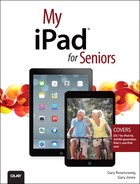7. Surfing the Web
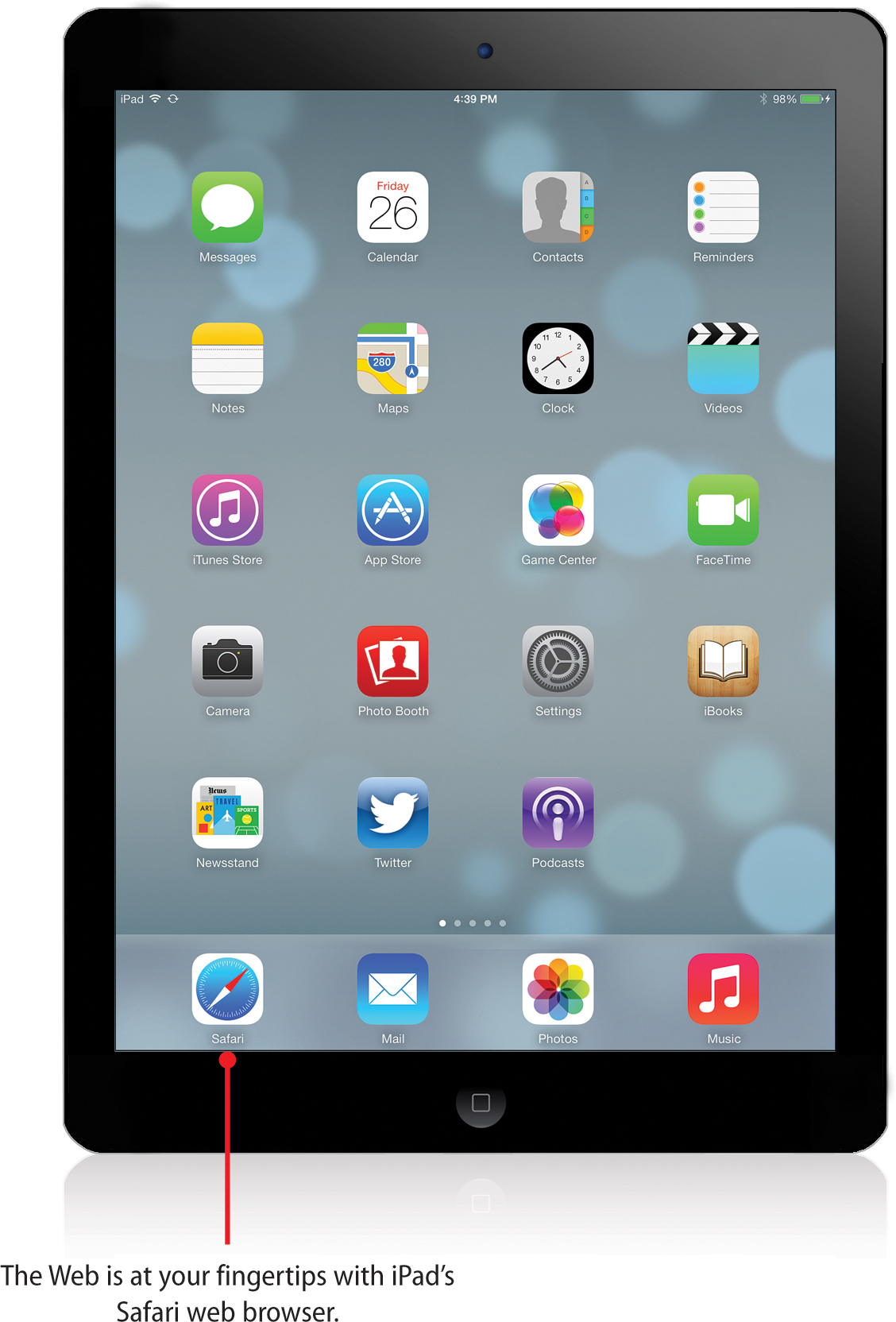
In this chapter, you learn about Safari, the browser built-in to the iPad. You can use it to browse the Web, bookmark web pages, fill in forms, and search the Internet.
→ Browsing to a URL and Searching
→ Bookmarks, History, and Reading List
→ Creating Home Screen Bookmarks
→ Opening Multiple Web Pages with Tabs
→ Copying Text from a Web Page
→ Copying Images from Web Pages
→ Viewing Articles with Safari Reader
The iPad is a beautiful web surfing device. Its size is perfect for web pages, and your ability to touch the screen lets you interact with content in a way that even a computer typically cannot.
Browsing to a URL and Searching
Undoubtedly, you know how to get to web pages on a computer using a web browser. You use Safari on your iPad in the same way, but the interface is a little different.
At the top of the Safari browser is a toolbar with just a few buttons. In the middle, the largest interface element is the address field. This is where you can type the address of any web page on the Internet, or enter a search query.
![]() Touch the Safari icon on your iPad to launch the browser. It might be located at the bottom of the screen, along with your other most commonly used applications.
Touch the Safari icon on your iPad to launch the browser. It might be located at the bottom of the screen, along with your other most commonly used applications.
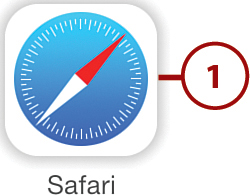
![]() Tap in the field at the top of the screen. This opens up the keyboard at the bottom of the screen. If you were already viewing a web page, the address of that page remains in the address field. Otherwise, it will be blank.
Tap in the field at the top of the screen. This opens up the keyboard at the bottom of the screen. If you were already viewing a web page, the address of that page remains in the address field. Otherwise, it will be blank.
Clear the Slate
To clear the field at any time, tap the X button located inside the field all the way to the right.
![]() Start typing a search term or a URL such as apple.com or macmost.com.
Start typing a search term or a URL such as apple.com or macmost.com.
![]() The area to the right of where you are typing will fill with a complete address and description, trying to predict the URL you want. You can ignore this and keep typing until you have completed the URL. You can then skip to step 6.
The area to the right of where you are typing will fill with a complete address and description, trying to predict the URL you want. You can ignore this and keep typing until you have completed the URL. You can then skip to step 6.
![]() As you type, suggestions based on previous pages you have visited and past web searches from other users appear. To go directly to one of these pages, tap the page in the list.
As you type, suggestions based on previous pages you have visited and past web searches from other users appear. To go directly to one of these pages, tap the page in the list.
![]() Tap the Go button on the keyboard when you finish typing. If you typed or selected a URL, you will be taken to that web page.
Tap the Go button on the keyboard when you finish typing. If you typed or selected a URL, you will be taken to that web page.
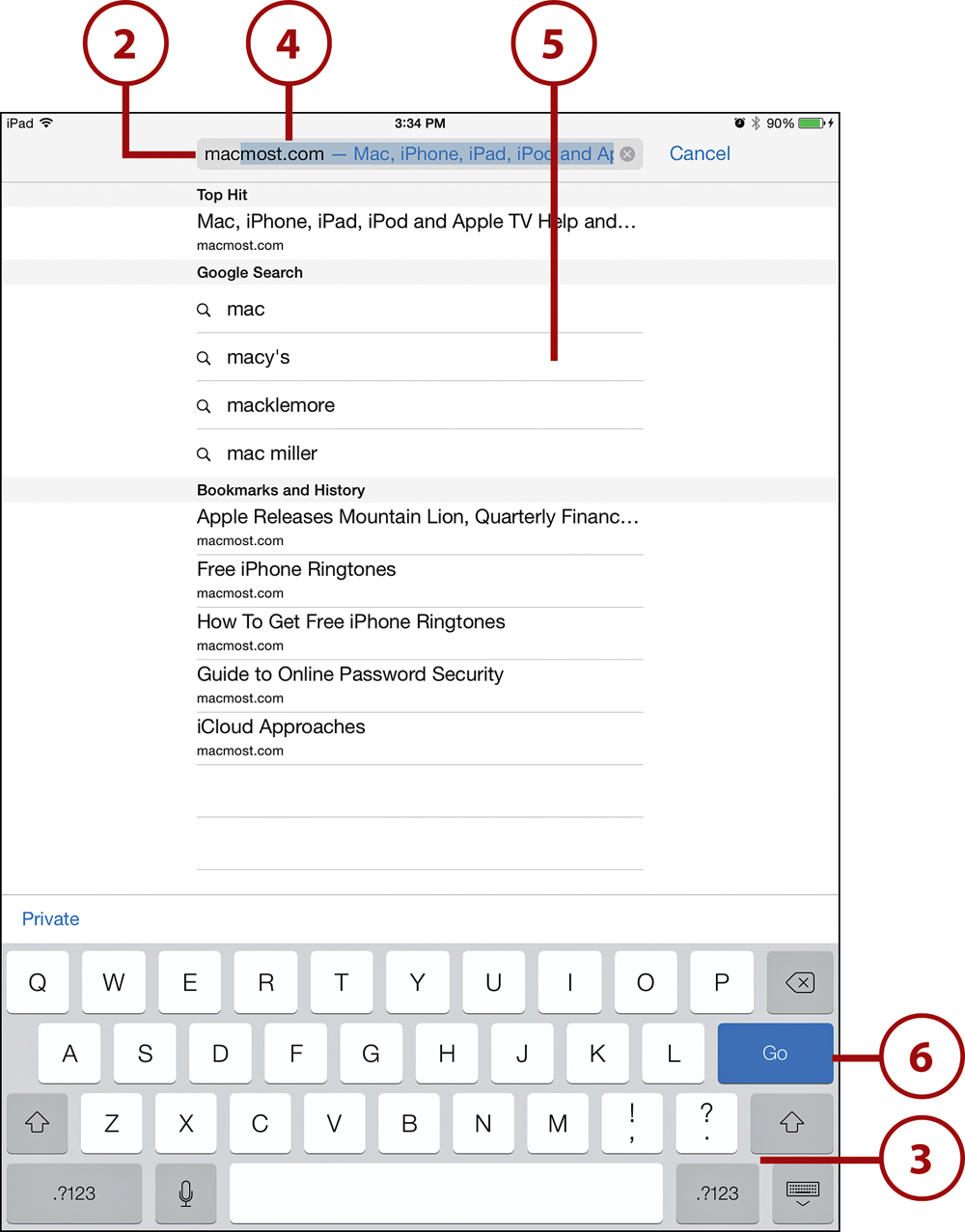
![]() Notice that the address field at the top of the screen shows you the domain name for the website you are visiting, but doesn’t display the complete URL of the specific page of that site you are on.
Notice that the address field at the top of the screen shows you the domain name for the website you are visiting, but doesn’t display the complete URL of the specific page of that site you are on.
If you typed a search term, or selected a search from the list, the term will remain at the top and you will get a page of search results.
![]() Tap on any result to jump to that page.
Tap on any result to jump to that page.

Some websites present you with a special iPad version of the site. This is not as common as the special iPhone or iPod touch versions that many sites offer. If a website does not look the same on your iPad as it does on your computer, you might want to check to see if a switch is on the web page provided by the site to view the standard web version, instead of a special iPad version. This is especially useful if a site has lumped the iPad together with the iPhone and provided a needlessly simplified version.
Search This Page
Below Google Suggestions in the search suggestions drop-down menu is a list of recent searches and the occurrences of the phrase on the web page you are viewing. Use the latter to find the phrase on the page.
Siri: Search the Web
You can use Siri to search the web, even if you are not currently looking at the Safari screen. Sometimes Siri will also answer general questions by suggesting a web search:
“Search the web for iPad tutorials.”
“Search for local plumbers.”
“Search for MacMost.com.”
“Search Wikipedia for Paris.”
“Show me some websites about geology.”
“Google Denver news.”
“Search for iPad tutorials on MacMost.com.”
Viewing Web Pages
Whether you typed in a URL or searched for a web page, after you have one open on your iPad screen, you can control what you view in several ways. You need to know these techniques to view the complete contents of a web page and navigate among web pages.
![]() Navigate to any web page using either of the two techniques in the previous step-by-step instructions. When you arrive at the page, only the domain name shows at the top.
Navigate to any web page using either of the two techniques in the previous step-by-step instructions. When you arrive at the page, only the domain name shows at the top.
![]() When you are viewing a page, you can touch and drag the page up and down with your finger. As you do so, notice the bar on the right side that gives you an indication of how much of the complete web page you are viewing at one time.
When you are viewing a page, you can touch and drag the page up and down with your finger. As you do so, notice the bar on the right side that gives you an indication of how much of the complete web page you are viewing at one time.
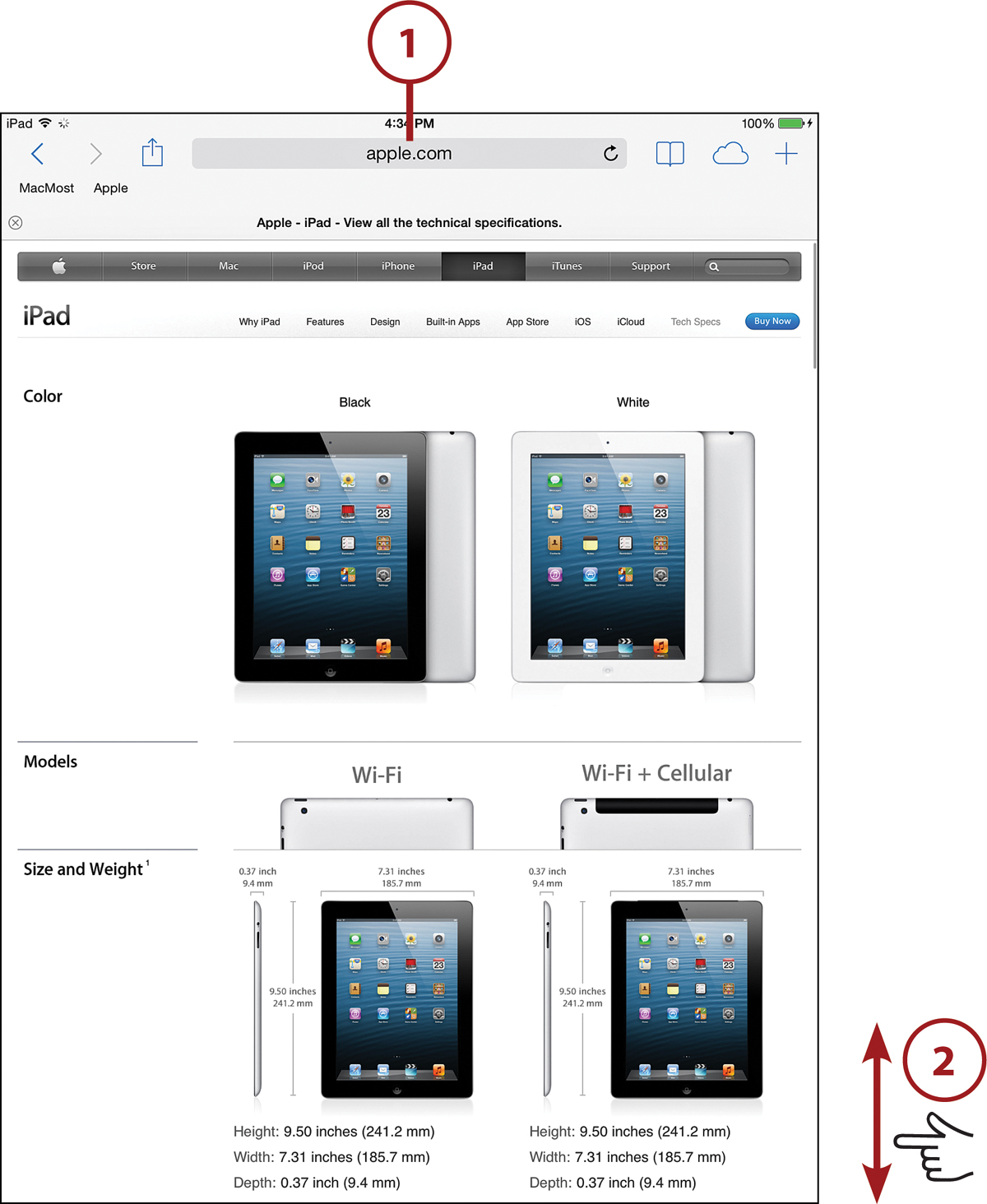
Flick It
If you release your finger from the iPad screen to stop scrolling while dragging, the screen will continue to scroll with a decelerating affect and then come to a stop quickly.
![]() To zoom in on an area in the page, touch the screen with two fingers and move your fingers apart. This is called an unpinch. You can also move them closer together (pinch) to zoom back out. A double-tap restores the page to normal scaling. This works well on websites made for desktop computers, but mobile sites usually are set to already fit the screen at optimal resolution.
To zoom in on an area in the page, touch the screen with two fingers and move your fingers apart. This is called an unpinch. You can also move them closer together (pinch) to zoom back out. A double-tap restores the page to normal scaling. This works well on websites made for desktop computers, but mobile sites usually are set to already fit the screen at optimal resolution.
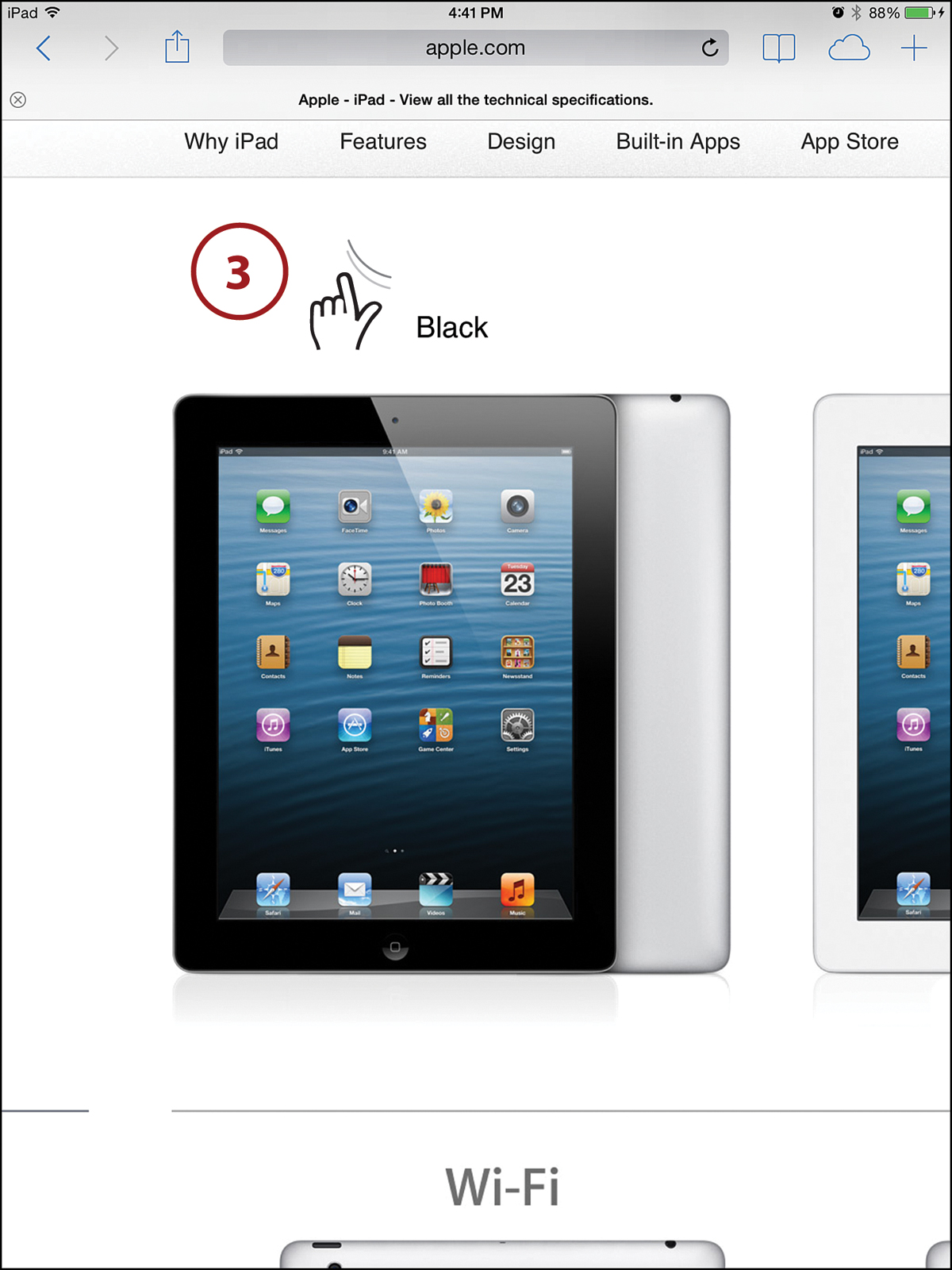
![]() You can also double-tap images and paragraphs of text to zoom in to those elements in the web page. A second double-tap zooms back out.
You can also double-tap images and paragraphs of text to zoom in to those elements in the web page. A second double-tap zooms back out.
![]() While zoomed in, you can also touch and drag left and right to view different parts of the web page. You see a bar at the bottom of the screen when you do this, just like the bar on the right side in step 2.
While zoomed in, you can also touch and drag left and right to view different parts of the web page. You see a bar at the bottom of the screen when you do this, just like the bar on the right side in step 2.
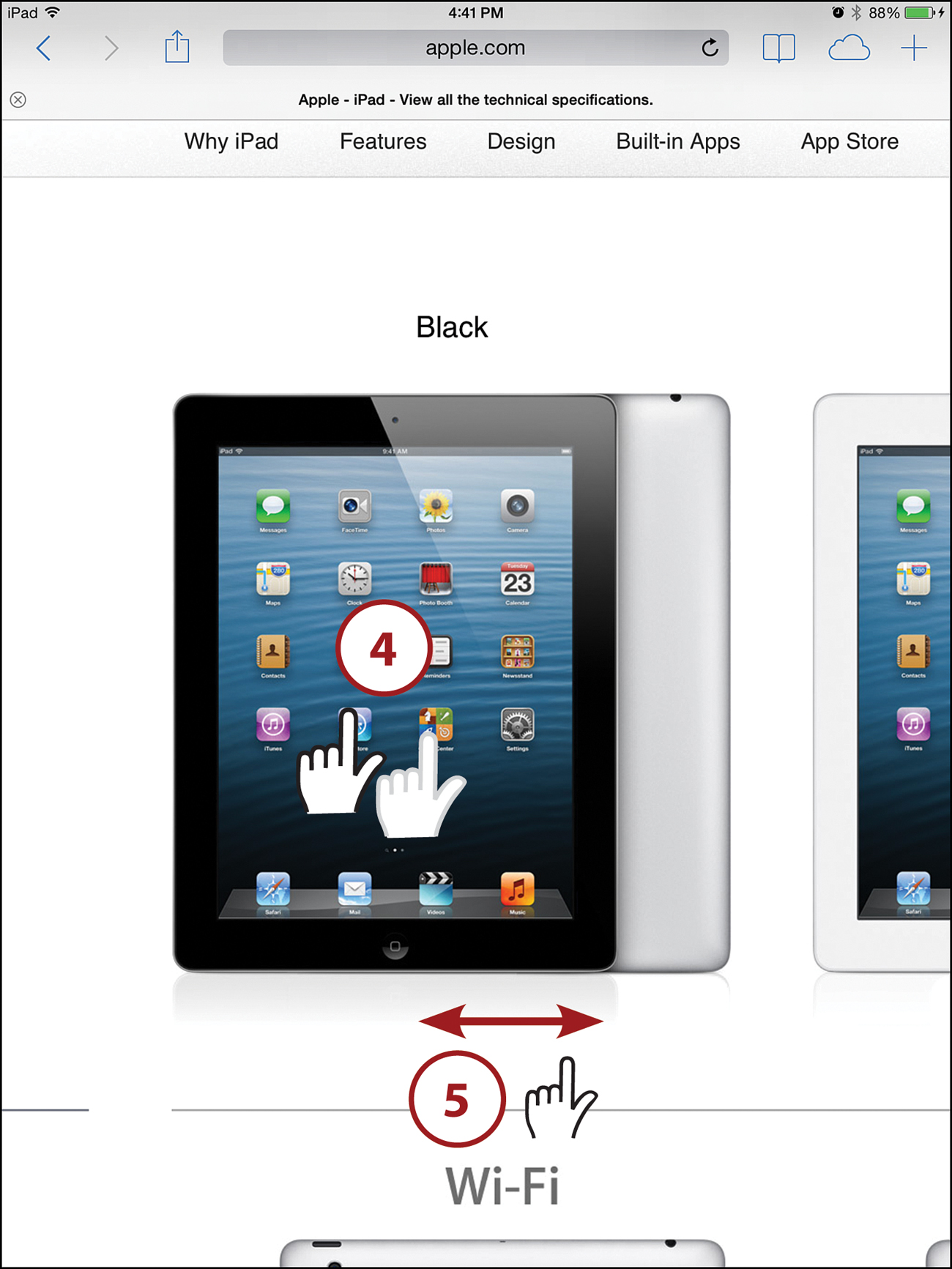
![]() To move to another web page from a link in the current web page, just tap the link. Links are usually an underlined or colored piece of text; however, they can also be pictures or button-like images.
To move to another web page from a link in the current web page, just tap the link. Links are usually an underlined or colored piece of text; however, they can also be pictures or button-like images.
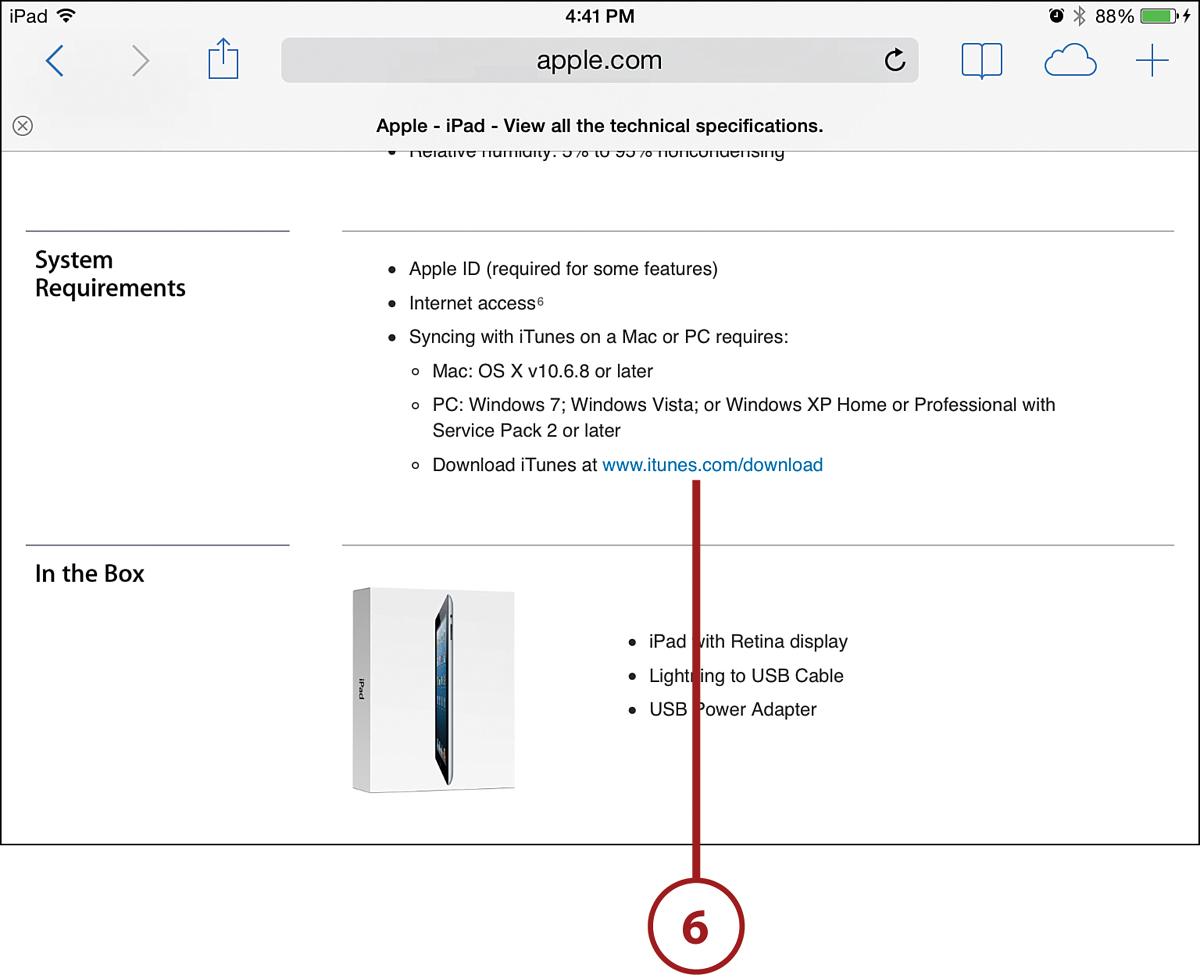
Bookmarks, History, and Reading List
You can always visit a web page by typing its address in the field at the top of Safari. But the app also has a way for you to get to your most frequently visited sites easily, find a page you recently visited, or save a page to read later.
Using Bookmarks and Favorites
Bookmarks allow you to save the web pages you visit most often and then access them with just a few taps. Favorites are bookmarks that appear at the top of the Safari browser for easier access.
![]() Use Safari to navigate to any web page.
Use Safari to navigate to any web page.
![]() Tap the Share button at the top of the screen.
Tap the Share button at the top of the screen.
![]() Tap Bookmark.
Tap Bookmark.
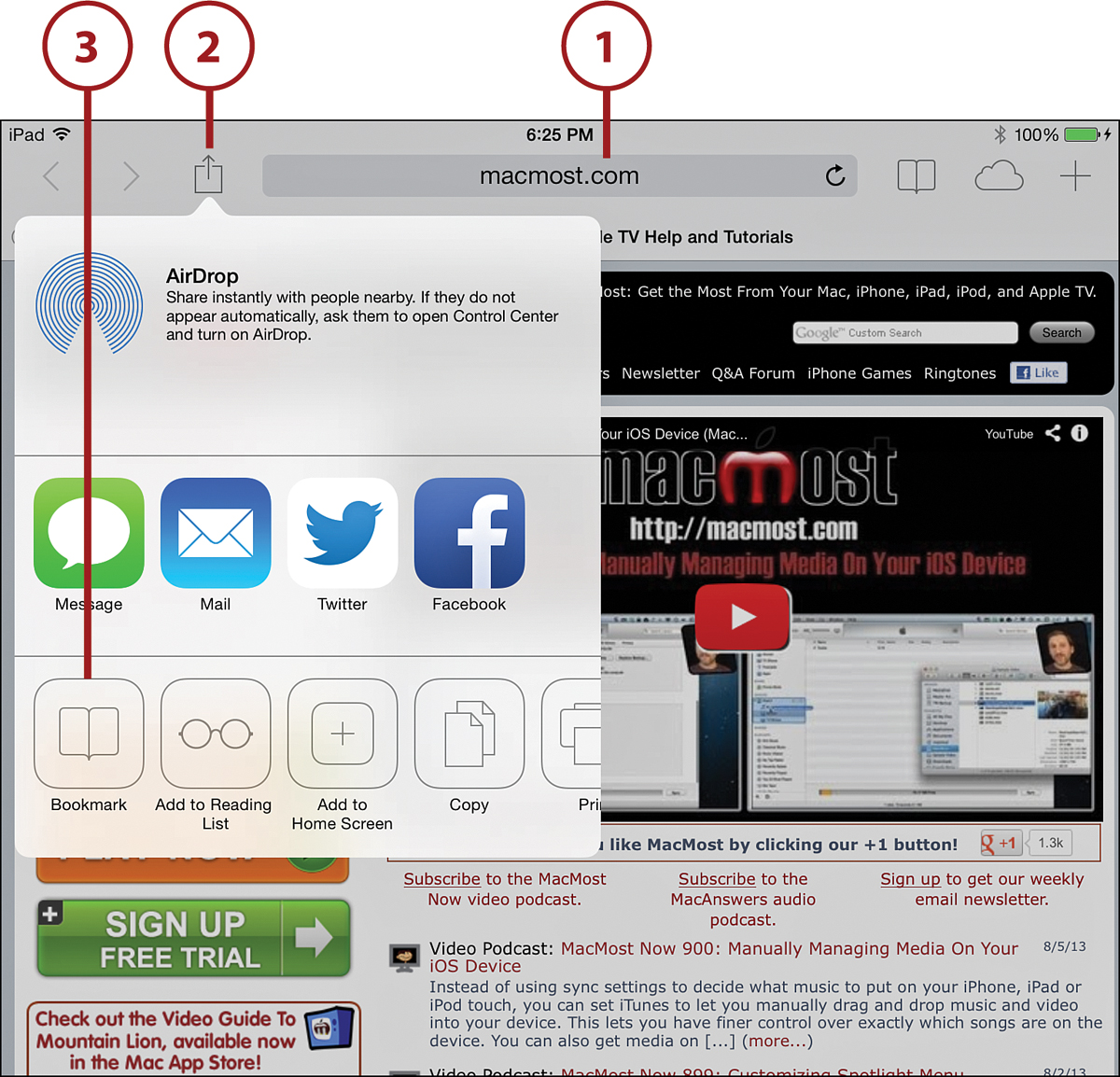
![]() Edit the title of the bookmark. The official title of the web page is prefilled, but you can use the keyboard to change it. You can tap the X to clear the text and start fresh.
Edit the title of the bookmark. The official title of the web page is prefilled, but you can use the keyboard to change it. You can tap the X to clear the text and start fresh.
![]() Tap Location to place the bookmark in a bookmarks folder.
Tap Location to place the bookmark in a bookmarks folder.
![]() You can choose to place the bookmark in Favorites, so it will appear at the top of the Safari window where you can easily find it.
You can choose to place the bookmark in Favorites, so it will appear at the top of the Safari window where you can easily find it.
![]() Or you can put it in Bookmarks, where you can select it from the Bookmarks menu.
Or you can put it in Bookmarks, where you can select it from the Bookmarks menu.
![]() Tap Save to finish creating the bookmark.
Tap Save to finish creating the bookmark.
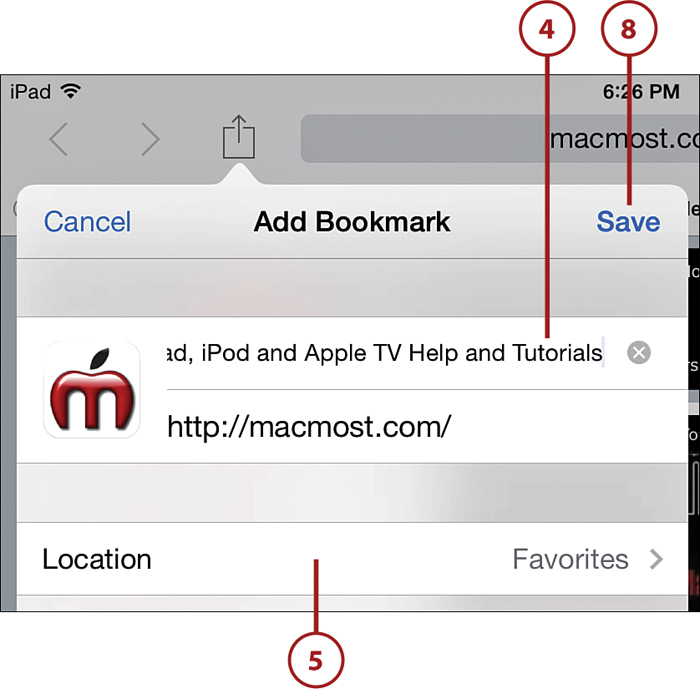
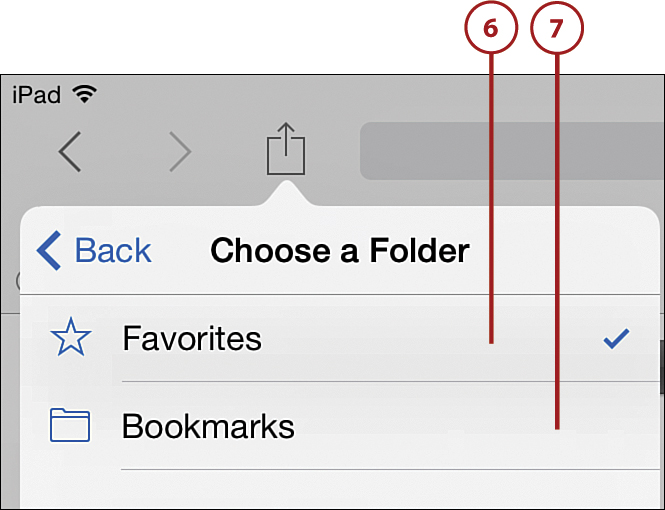
![]() To use a bookmark, first tap the Bookmarks button.
To use a bookmark, first tap the Bookmarks button.
![]() Find the bookmark in the list and tap it to go to that web page.
Find the bookmark in the list and tap it to go to that web page.
![]() If you put the bookmark in Favorites, or another folder, you have to tap that folder name first to dig down to find the bookmark.
If you put the bookmark in Favorites, or another folder, you have to tap that folder name first to dig down to find the bookmark.
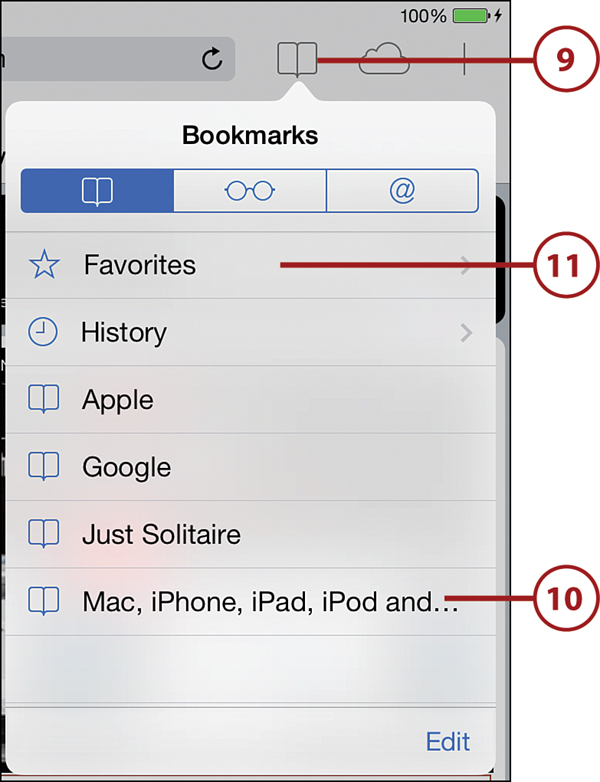
Using History
Safari keeps track of which web pages you have visited. You can use this history to find a page you went to earlier today, yesterday, or even several days back.
![]() After using Safari to view several pages, tap the Bookmarks button at the top of the screen.
After using Safari to view several pages, tap the Bookmarks button at the top of the screen.
![]() Tap the first tab at the top of this menu to view your bookmarks and history folders.
Tap the first tab at the top of this menu to view your bookmarks and history folders.
![]() You may already be viewing your history at this point. If the top of this menu reads History instead of Bookmarks, then you are. Otherwise, tap the History item to go into your history.
You may already be viewing your history at this point. If the top of this menu reads History instead of Bookmarks, then you are. Otherwise, tap the History item to go into your history.
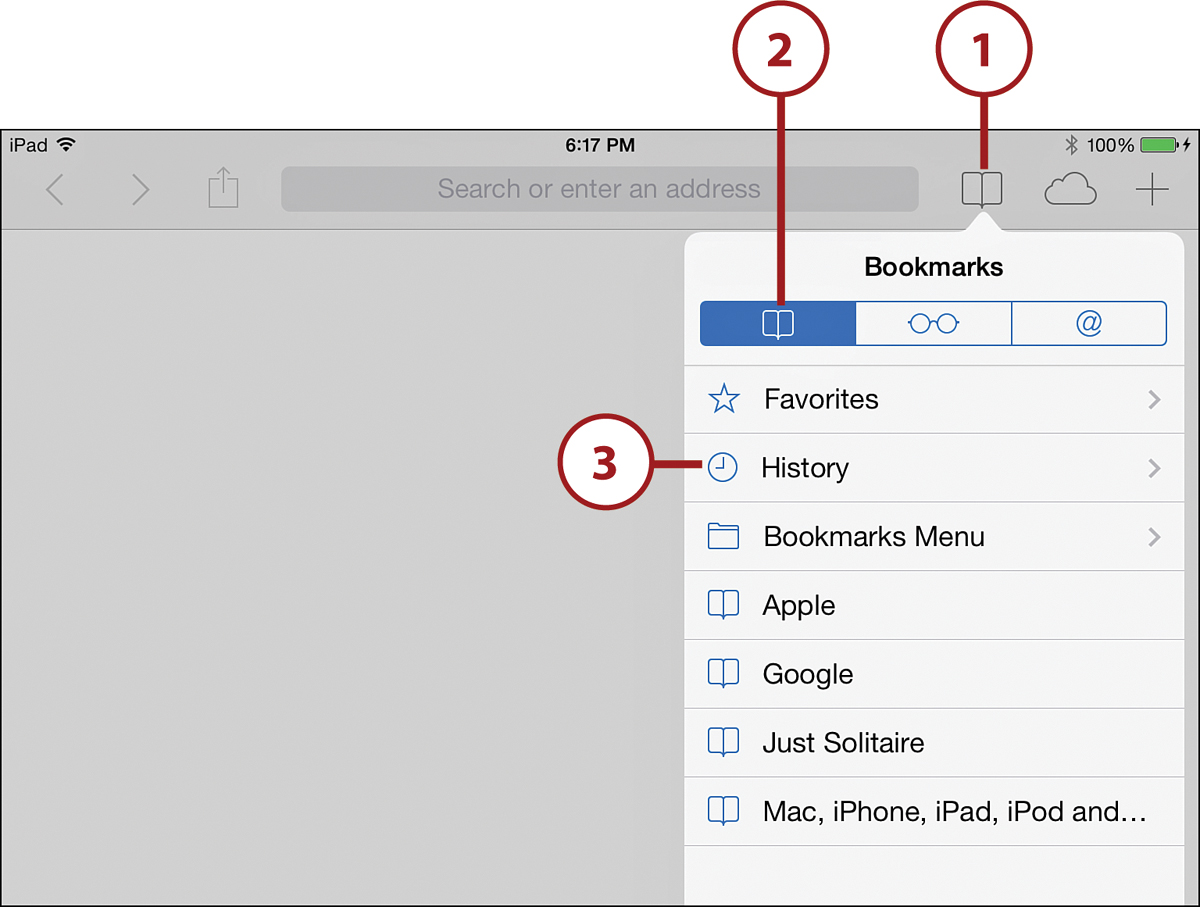
![]() Tap any item in the list to jump to that web page.
Tap any item in the list to jump to that web page.
![]() Previous pages you have visited are broken into groups by date.
Previous pages you have visited are broken into groups by date.
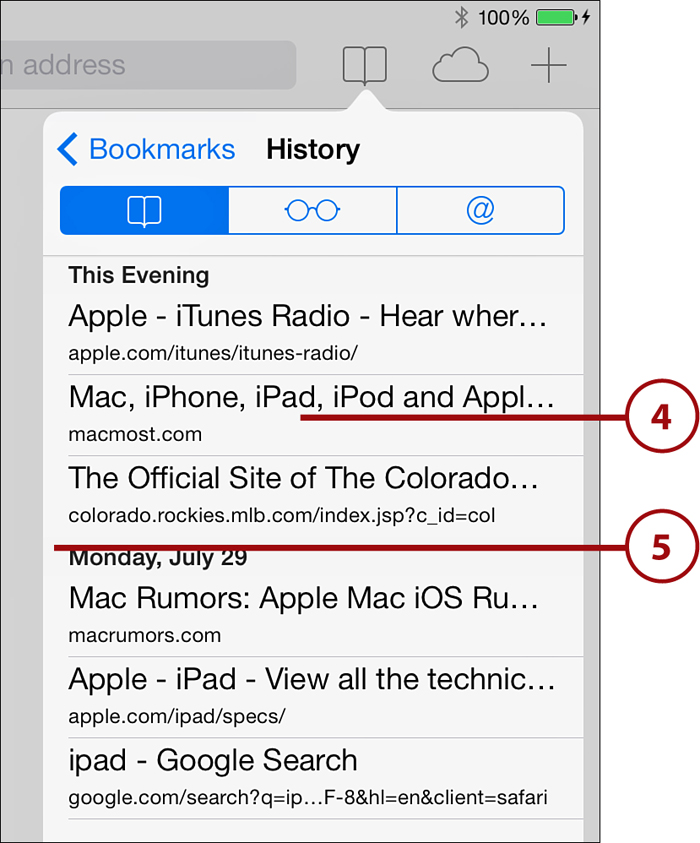
![]() You can clear your browsing history by tapping the Clear button.
You can clear your browsing history by tapping the Clear button.
History/Bookmarks
Safari treats both history and bookmarks the same. They are both just lists of web pages. Think of your history as a bookmark list of every site you have visited recently.
Deleting Your Bookmarks
Adding and using bookmarks is just the start. You eventually need to delete ones you don’t use. Some might link to missing or obsolete pages, or some you simply no longer use. There are two ways to delete a bookmark. The results of the two methods are the same; however, you might find the second method gives you a little more control.
Delete a Single Bookmark
The first method uses the Bookmarks list to locate and delete a single bookmark.
![]() Tap the Bookmarks button at the top of the Safari screen.
Tap the Bookmarks button at the top of the Safari screen.
![]() Navigate to the Bookmarks section of that menu.
Navigate to the Bookmarks section of that menu.
![]() Tap Edit.
Tap Edit.
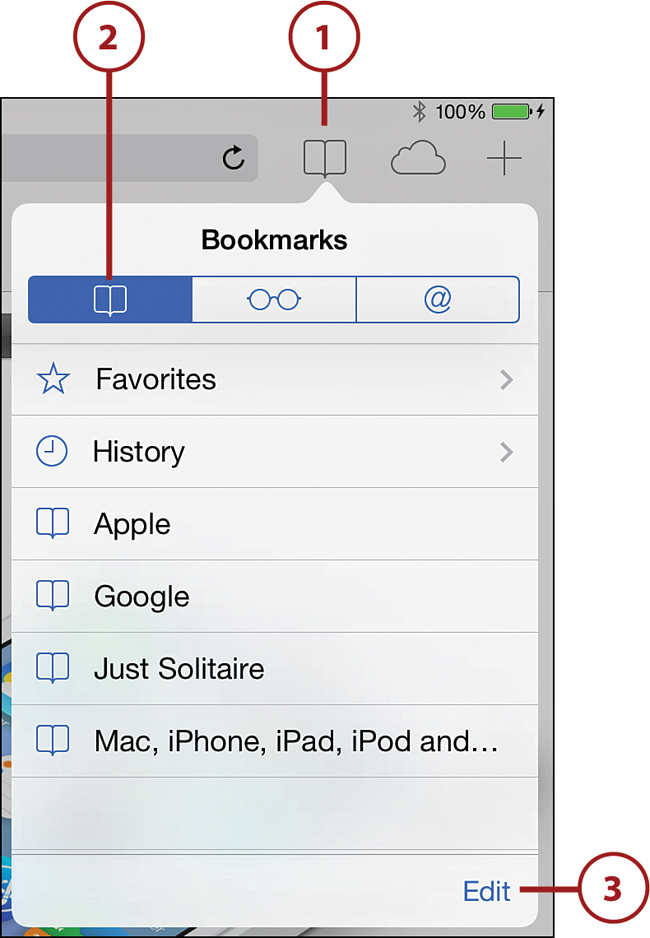
![]() Tap the red button next to a bookmark.
Tap the red button next to a bookmark.
![]() Tap the Delete button to remove the bookmark. The bookmark is instantly deleted.
Tap the Delete button to remove the bookmark. The bookmark is instantly deleted.
![]() Tap Done when you finish deleting bookmarks.
Tap Done when you finish deleting bookmarks.
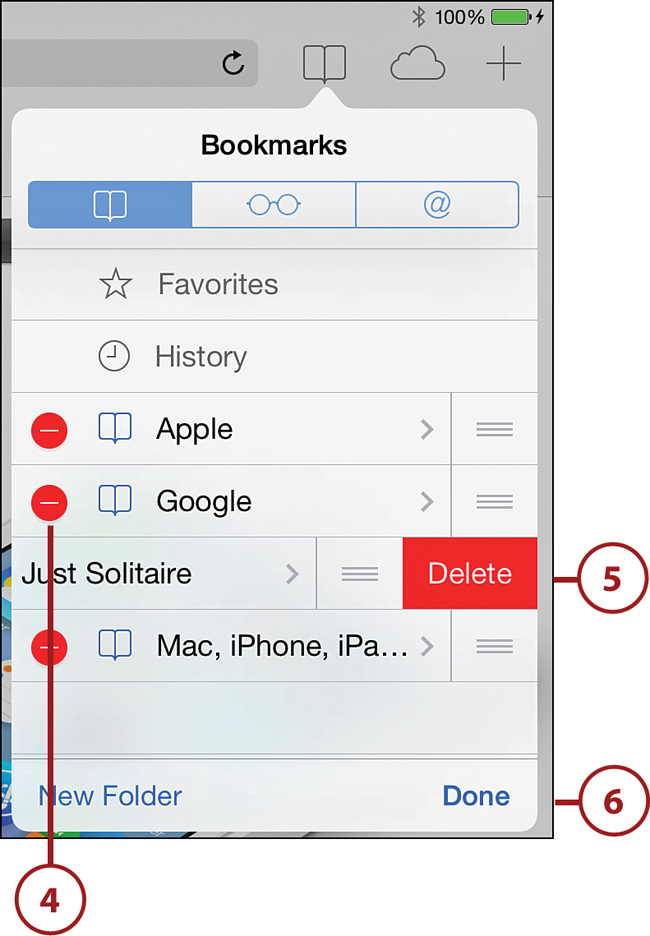
Sync Your Bookmarks
If you are using iCloud, your bookmarks should sync between all your iOS and Mac devices. Safari on your computer gives you greater control over moving and deleting bookmarks. So just do your wholesale editing on your computer and those changes should be reflected in your iPad’s bookmarks as well.
Creating Home Screen Bookmarks
If a web page is somewhat important, you might want to create a bookmark for it. If it is extremely important and you need to go to it often, you might want to make sure that bookmark is saved to your Bookmarks Bar so that it is easily accessible.
However, if a web page is even more important to you than that, you can save it as an icon on your iPad’s Home screen.
![]() Use Safari to navigate to any web page.
Use Safari to navigate to any web page.
![]() Tap the Share button at the top of the screen.
Tap the Share button at the top of the screen.
![]() Tap Add to Home Screen. Note that the icon shown here will change to use the icon for that website or to a small screen capture of the site.
Tap Add to Home Screen. Note that the icon shown here will change to use the icon for that website or to a small screen capture of the site.

Managing Home Screen Bookmarks
You can arrange and delete Home screen bookmarks just like icons that represent apps.
![]() You can now edit the name of the page. Most web page titles are too long to display under an icon on the Home screen of the iPad, so edit the name down to as short a title as possible.
You can now edit the name of the page. Most web page titles are too long to display under an icon on the Home screen of the iPad, so edit the name down to as short a title as possible.
![]() You can tap Cancel to leave this interface without sending the bookmark to the Home screen.
You can tap Cancel to leave this interface without sending the bookmark to the Home screen.
![]() Tap Add to complete adding the icon to the Home screen.
Tap Add to complete adding the icon to the Home screen.

![]() Press the Home button to return to your Home screen.
Press the Home button to return to your Home screen.
![]() Look for the new icon on your Home screen that represents this bookmark. You may need to swipe through the pages of your Home screens to find it. Then, you can move it to any page or into a folder. The icon acts just like the app icons on your Home screen.
Look for the new icon on your Home screen that represents this bookmark. You may need to swipe through the pages of your Home screens to find it. Then, you can move it to any page or into a folder. The icon acts just like the app icons on your Home screen.
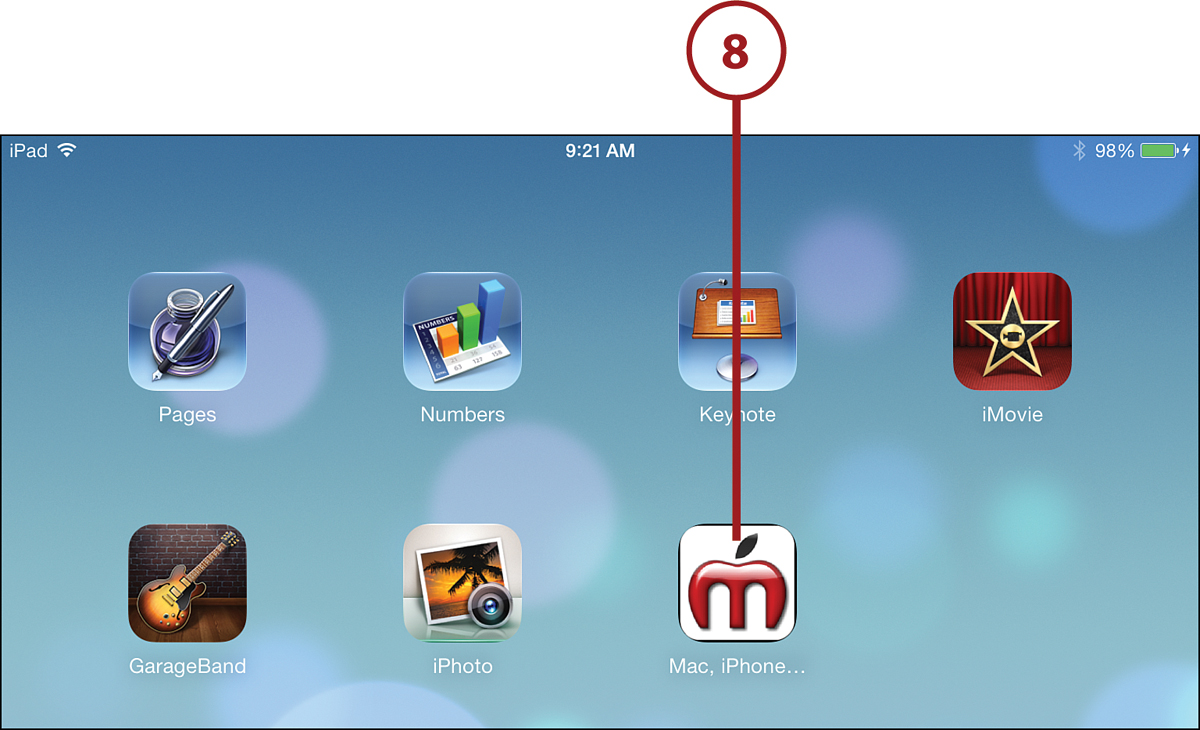
The icon for this type of bookmark can come from one of two sources. Web page owners can provide a special iPhone/iPad icon that would be used whenever someone tries to bookmark her page.
However, if no such icon has been provided, your iPad will take a screen shot of the web page and shrink it down to make an icon.
Building a Reading List
Your reading list is similar to bookmarks. You can add a page to your reading list to remember to return to that page later. When you do, it will be removed from the Unread section of your reading list, but still appear in the All section.
In addition, pages you add to your reading list are downloaded to your iPad so that you can read them later while not connected to the Internet.
![]() Find an article you want to read later.
Find an article you want to read later.
![]() Tap the Share button.
Tap the Share button.
![]() Tap Add to Reading List.
Tap Add to Reading List.
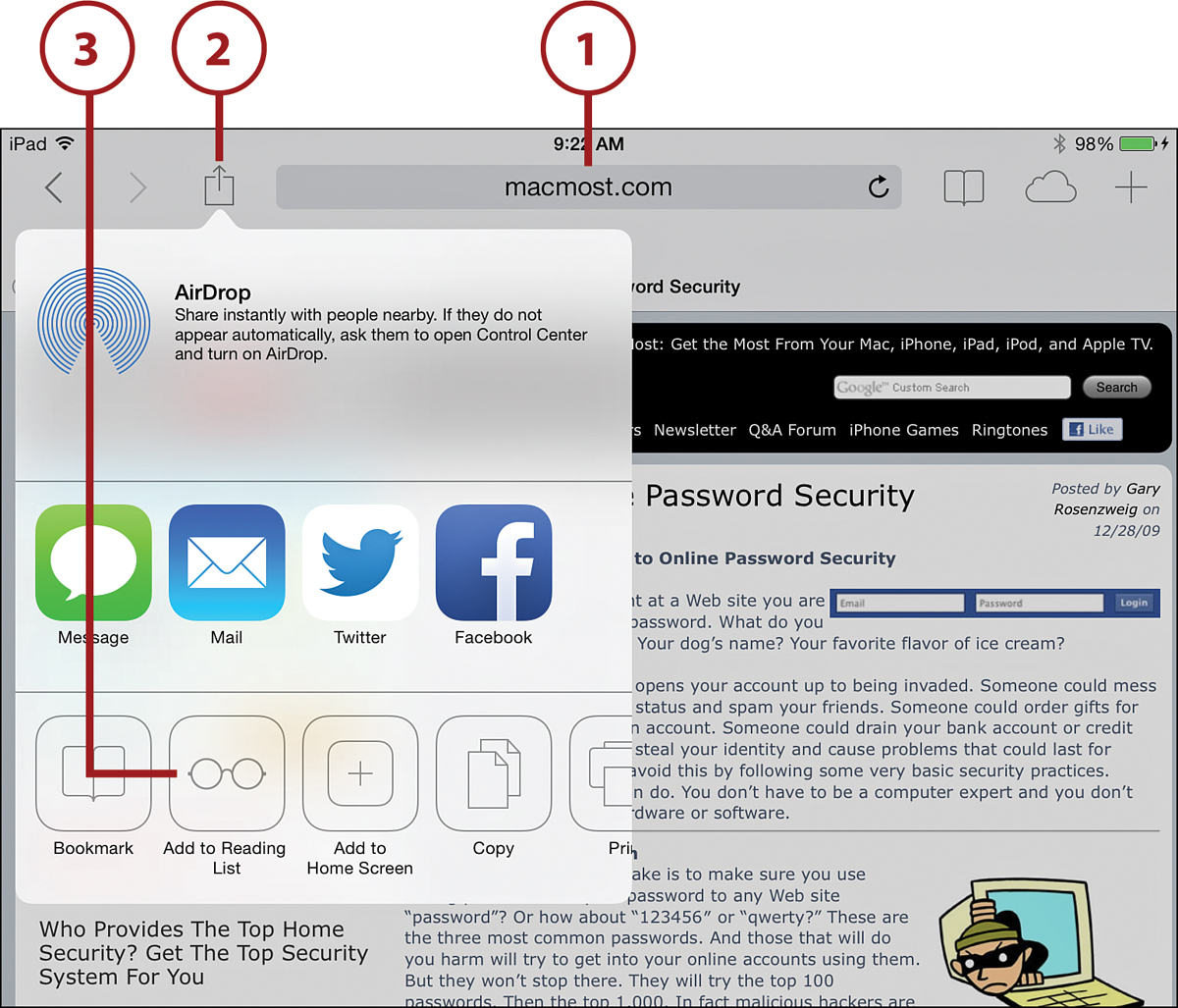
![]() To see your reading list, tap the Bookmarks button.
To see your reading list, tap the Bookmarks button.
![]() Tap the Reading List button.
Tap the Reading List button.
![]() Tap any item to view the page. Even if you are not connected to the Internet, the page will show because Safari stored the content when you added the page to the Reading List.
Tap any item to view the page. Even if you are not connected to the Internet, the page will show because Safari stored the content when you added the page to the Reading List.
![]() At the bottom you see either Show All or Show Unread. This lets you switch between the two lists. Show All shows everything in your Reading List. Show Unread does not show items you have already opened from the Reading List.
At the bottom you see either Show All or Show Unread. This lets you switch between the two lists. Show All shows everything in your Reading List. Show Unread does not show items you have already opened from the Reading List.
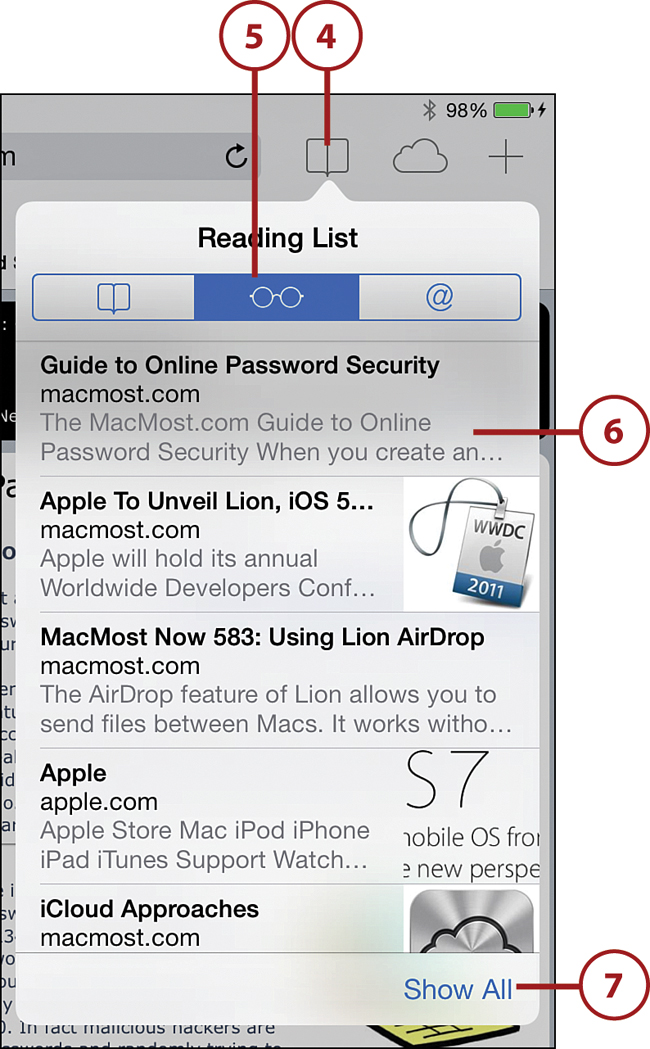
Reading List Syncing
The Reading List also syncs across your iOS devices and Macs using iCloud. So you can add it on your Mac and then see it appear in your Reading List on your iPad.
Shared Links
In addition to Bookmarks and Reading List, there is a third button that looks like an @ symbol that appears only if you are signed into social media networks like Twitter or Facebook in the Settings app. Here you find shared links. Recently shared links from those networks appear in this list.
Filling in Web Forms
The Web isn’t a one-way street. Often you need to interact with web pages, filling in forms or text fields. Doing this on the iPad is similar to doing it on a computer, but with a few key differences.
The keyboard shares screen space with the web page, so when you tap on a field, you bring up the keyboard at the bottom of the screen.
Also pull-down menus behave differently. On the iPad, you get a special menu showing you all the options.
![]() Use Safari to navigate to a web page with a form. For demonstration purposes, try one of the pages at http://apple.com/feedback/.
Use Safari to navigate to a web page with a form. For demonstration purposes, try one of the pages at http://apple.com/feedback/.
![]() To type in a text field, tap that field.
To type in a text field, tap that field.
![]() The keyboard appears at the bottom of the screen. Use it to type text into the field.
The keyboard appears at the bottom of the screen. Use it to type text into the field.
![]() Tap the Go button when you finish filling in all the required fields.
Tap the Go button when you finish filling in all the required fields.
![]() To select a check box or radio button, tap it just as you would click on it on your computer using the mouse.
To select a check box or radio button, tap it just as you would click on it on your computer using the mouse.

![]() To select an item in a pull-down menu, tap the menu.
To select an item in a pull-down menu, tap the menu.
![]() The special iPad pull-down menu reacts like any other iPad interface. You can tap an item to select it. You can touch and drag up and down to view more selections if the list is long.
The special iPad pull-down menu reacts like any other iPad interface. You can tap an item to select it. You can touch and drag up and down to view more selections if the list is long.
![]() A check mark appears next to the currently selected item. Tap that item or any other one to select it and dismiss the menu.
A check mark appears next to the currently selected item. Tap that item or any other one to select it and dismiss the menu.
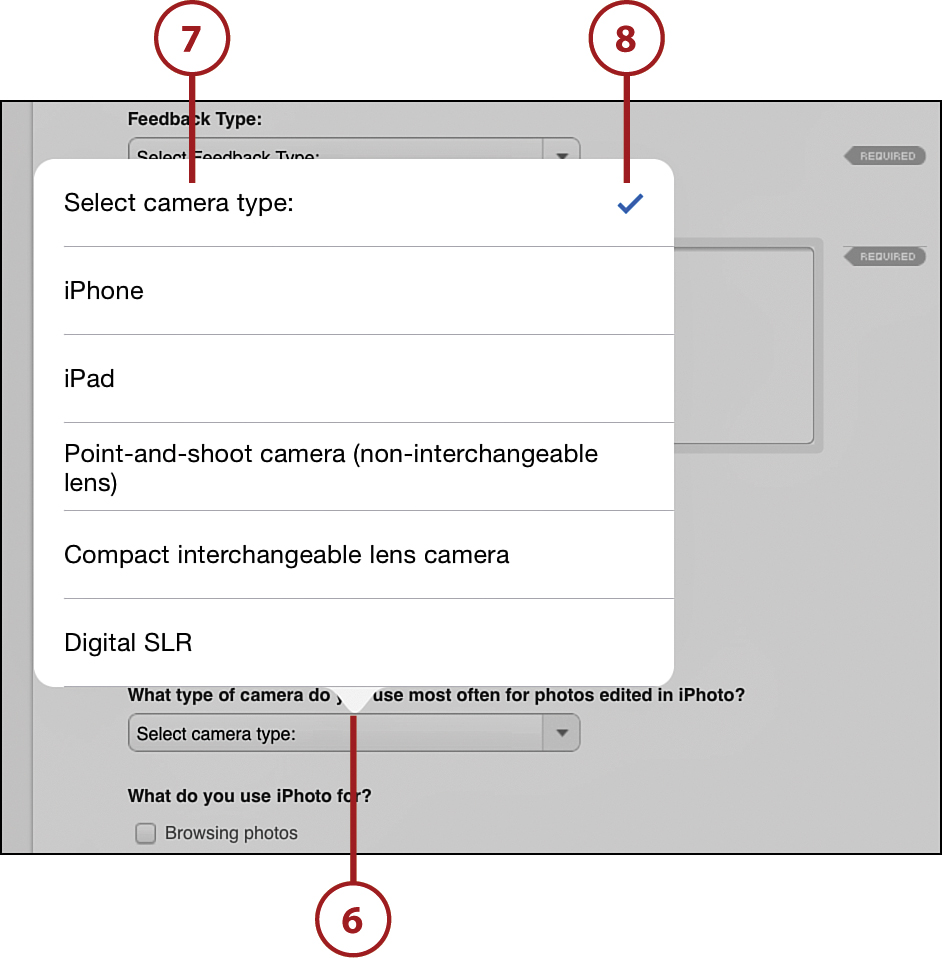
Special Menus
Some websites may use special menus that they build from scratch, rather than these default HTML menus. When this is the case, you get a menu that looks exactly like the one you get when viewing the web page on a computer. If the web page is well coded, it should work fine on the iPad, though it might be slightly more difficult to make a selection.
Opening Multiple Web Pages with Tabs
Safari on the iPad enables you to open multiple web pages at the same time. You can view only one at a time, but you can hold your place on a page while you look at something on another page.
![]() Instead of tapping on a link, tap down and hold your finger there until a contextual menu pops up above your finger.
Instead of tapping on a link, tap down and hold your finger there until a contextual menu pops up above your finger.
![]() Tap Open in New Tab.
Tap Open in New Tab.
![]() Alternatively, you can tap the + button at the top of the screen to open a new tab that shows icons linking to the websites you have put in your Favorites.
Alternatively, you can tap the + button at the top of the screen to open a new tab that shows icons linking to the websites you have put in your Favorites.
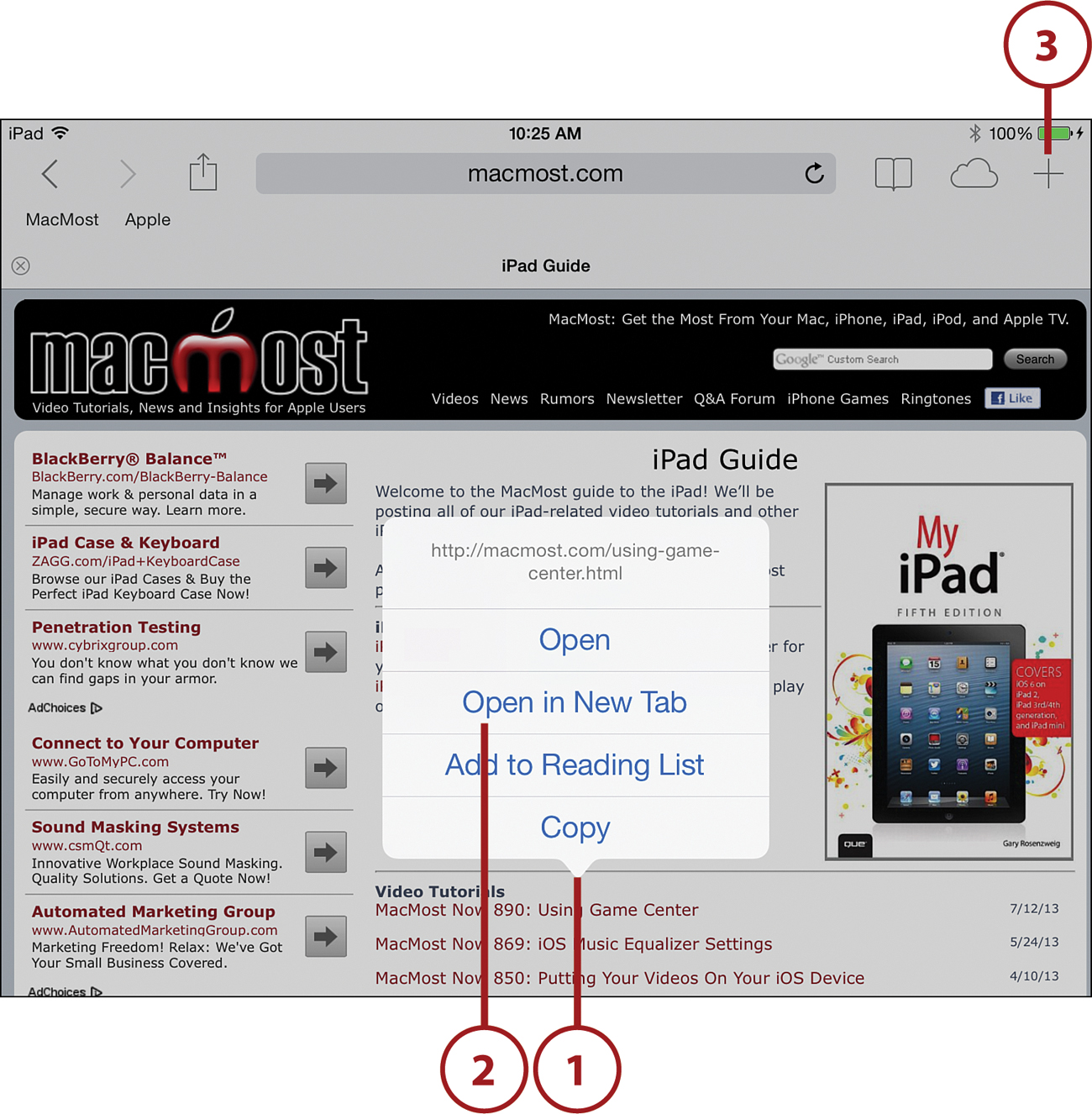
![]() You see two tabs at the top of the screen now. The one on the right is in front of the one on the left and represents the page you are looking at below.
You see two tabs at the top of the screen now. The one on the right is in front of the one on the left and represents the page you are looking at below.
![]() You can switch tabs by tapping on the other tab; that tab now appears front of the one on the right, and the screen area below shows that page.
You can switch tabs by tapping on the other tab; that tab now appears front of the one on the right, and the screen area below shows that page.
![]() When you enter a new web address, search, or use a bookmark, it changes the page of the current tab, but doesn’t affect the other tab.
When you enter a new web address, search, or use a bookmark, it changes the page of the current tab, but doesn’t affect the other tab.
![]() You can close the current tab by tapping the X button to the left of the tab’s name.
You can close the current tab by tapping the X button to the left of the tab’s name.

If you have iCloud set up on multiple iOS devices and/or Macs running Mountain Lion, you may see a cloud icon in the Safari toolbar next to the Bookmarks button. Tap that and you will see tabs that are currently open on those other devices. You can select one item to open that page. This means you can surf on your Mac for a while, and then switch to the iPad and easily find the pages you were just looking at on your Mac.
Copying Text from a Web Page
You can select text from web pages to copy and paste into your own documents or email messages.
![]() Use Safari to navigate to a web page.
Use Safari to navigate to a web page.
![]() Tap and hold over a piece of text. You don’t need to be exact because you can adjust the selection later. The word Copy appears above the selected area that is highlighted in light blue.
Tap and hold over a piece of text. You don’t need to be exact because you can adjust the selection later. The word Copy appears above the selected area that is highlighted in light blue.
![]() You can tap and drag one of the four blue dots to change the selection area. When your selection gets small enough, it changes to only two blue dots indicating the first and last character of the selection.
You can tap and drag one of the four blue dots to change the selection area. When your selection gets small enough, it changes to only two blue dots indicating the first and last character of the selection.
![]() Tap outside the selection at any time to cancel the selection.
Tap outside the selection at any time to cancel the selection.
![]() Tap the Copy button over the selection to copy the text.
Tap the Copy button over the selection to copy the text.
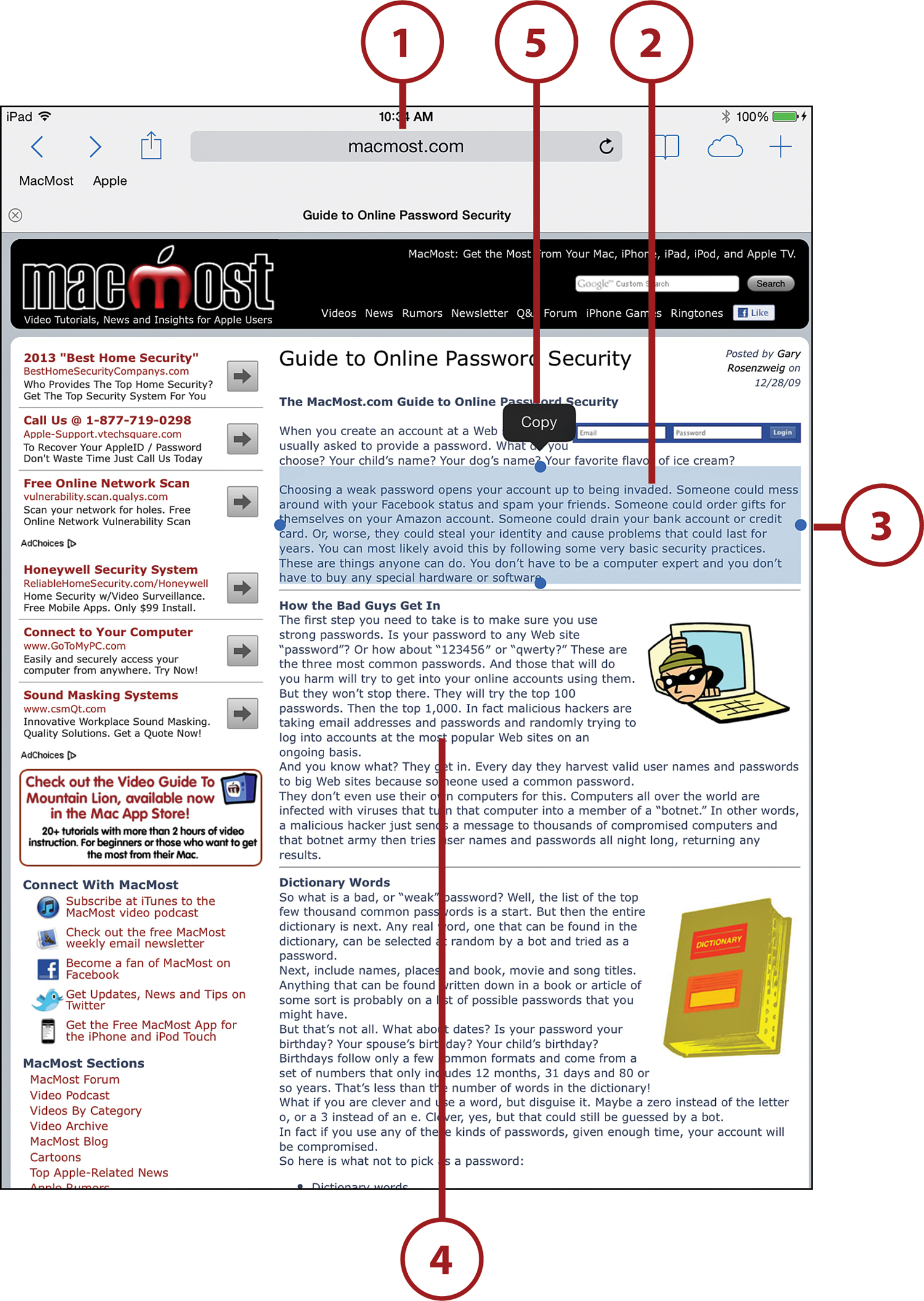
![]() You can now go to another application such as Mail or Pages and tap in a text area to choose Paste and paste the text into the area. You can also do this in a form on a page in Safari, such as a web-based email form.
You can now go to another application such as Mail or Pages and tap in a text area to choose Paste and paste the text into the area. You can also do this in a form on a page in Safari, such as a web-based email form.
If you select only a single word in Safari, or just tap and hold any word in the text of a web page, you get the menu with Copy as an option as well as a second option: Define. Use this to get a quick definition of a word in a little window that overlays the web page.
Copying Images from Web Pages
Along with copying and pasting text from Safari, you can copy images and save them to your photo collection.
![]() Use Safari to navigate to a web page that has an image you want to save.
Use Safari to navigate to a web page that has an image you want to save.
![]() Tap and hold your finger on that image until the contextual menu appears.
Tap and hold your finger on that image until the contextual menu appears.
![]() The menu shows you the title of the image and some options. If the image is also a link to another web page, you might see options to Open that page here as well.
The menu shows you the title of the image and some options. If the image is also a link to another web page, you might see options to Open that page here as well.
![]() Select Copy to copy the image to the Clipboard. You can then go to a program such as Mail or Pages and paste that image into the document you are composing.
Select Copy to copy the image to the Clipboard. You can then go to a program such as Mail or Pages and paste that image into the document you are composing.
![]() Alternatively, you can tap Save Image and put a copy of the image in your Camera Roll. This may be a good option because many apps use the Camera Roll to allow you to import, edit, share, and do other things to images.
Alternatively, you can tap Save Image and put a copy of the image in your Camera Roll. This may be a good option because many apps use the Camera Roll to allow you to import, edit, share, and do other things to images.
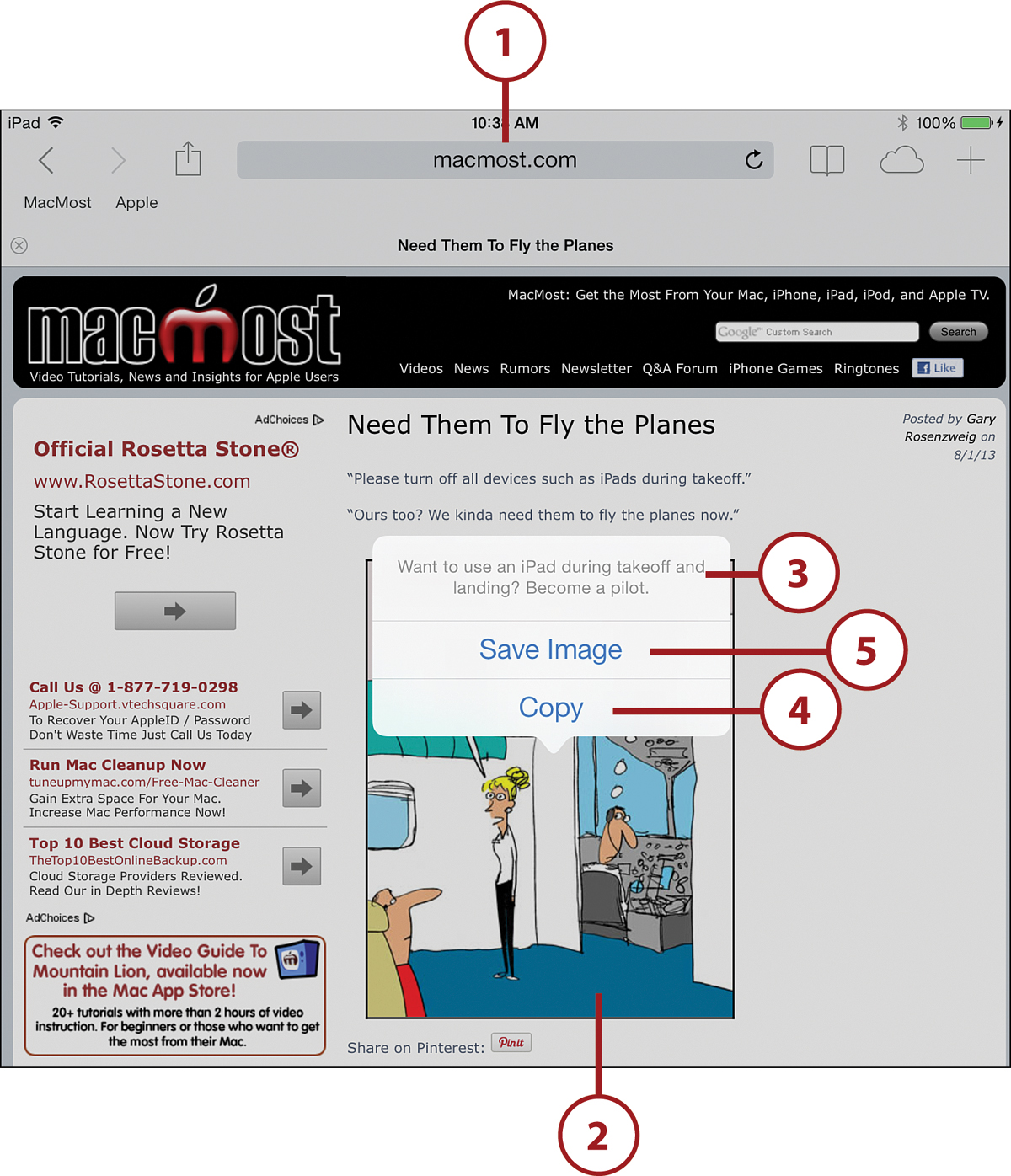
Viewing Articles with Safari Reader
Web pages on the iPad can be vibrant and pretty. But sometimes the website tries to cram so much text and other junk onto a page that it can be painful to read. You can clear away all the clutter to reveal the text of a news article or blog post using the Reader feature.
![]() Look for the Reader button in the address field. It will only appear on some news articles and blog posts. Tap it to enter the Reader mode.
Look for the Reader button in the address field. It will only appear on some news articles and blog posts. Tap it to enter the Reader mode.
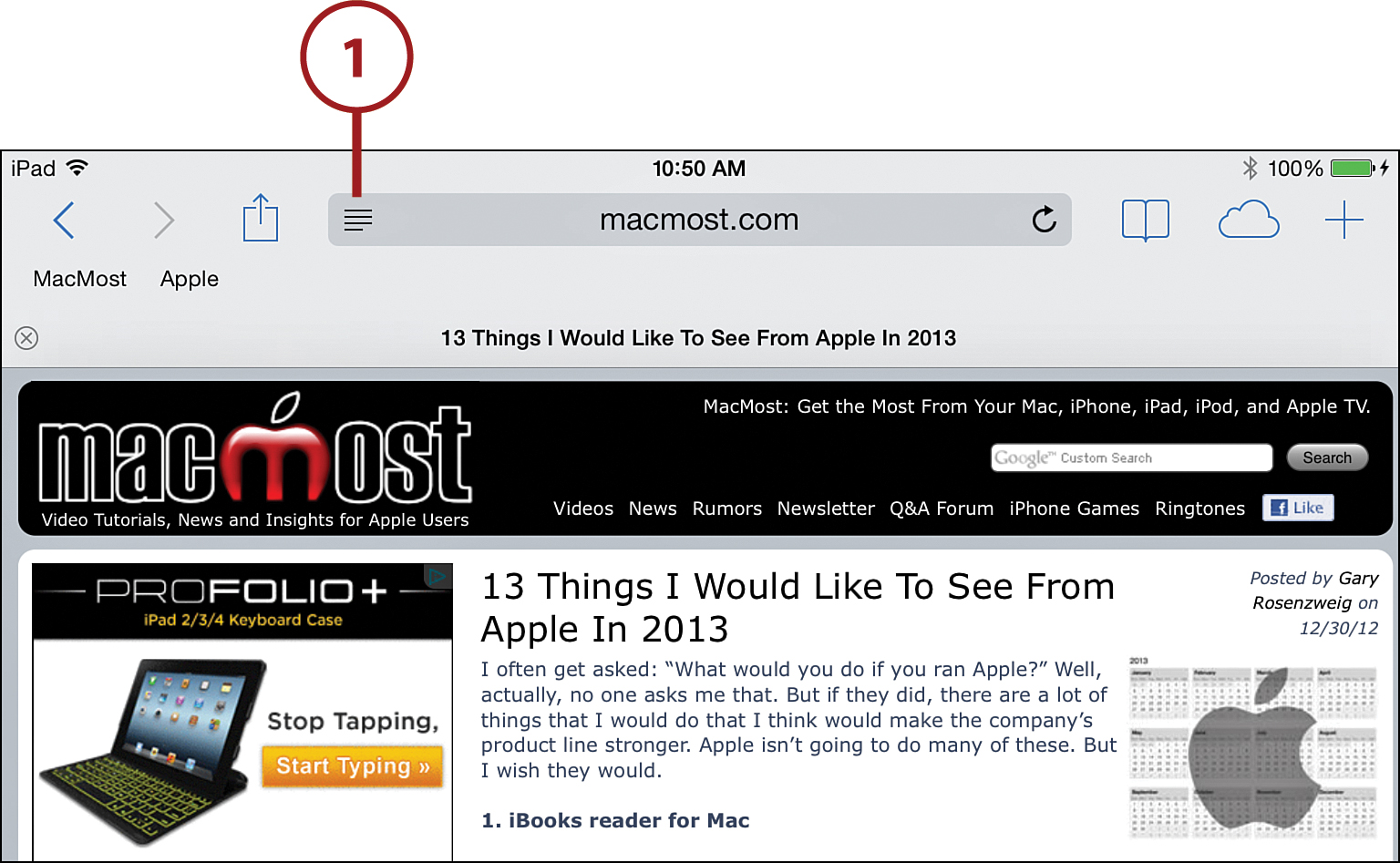
![]() In Reader mode, only the text and inline images of the article appear.
In Reader mode, only the text and inline images of the article appear.
![]() Tap Reader again to return to the regular view of the page.
Tap Reader again to return to the regular view of the page.
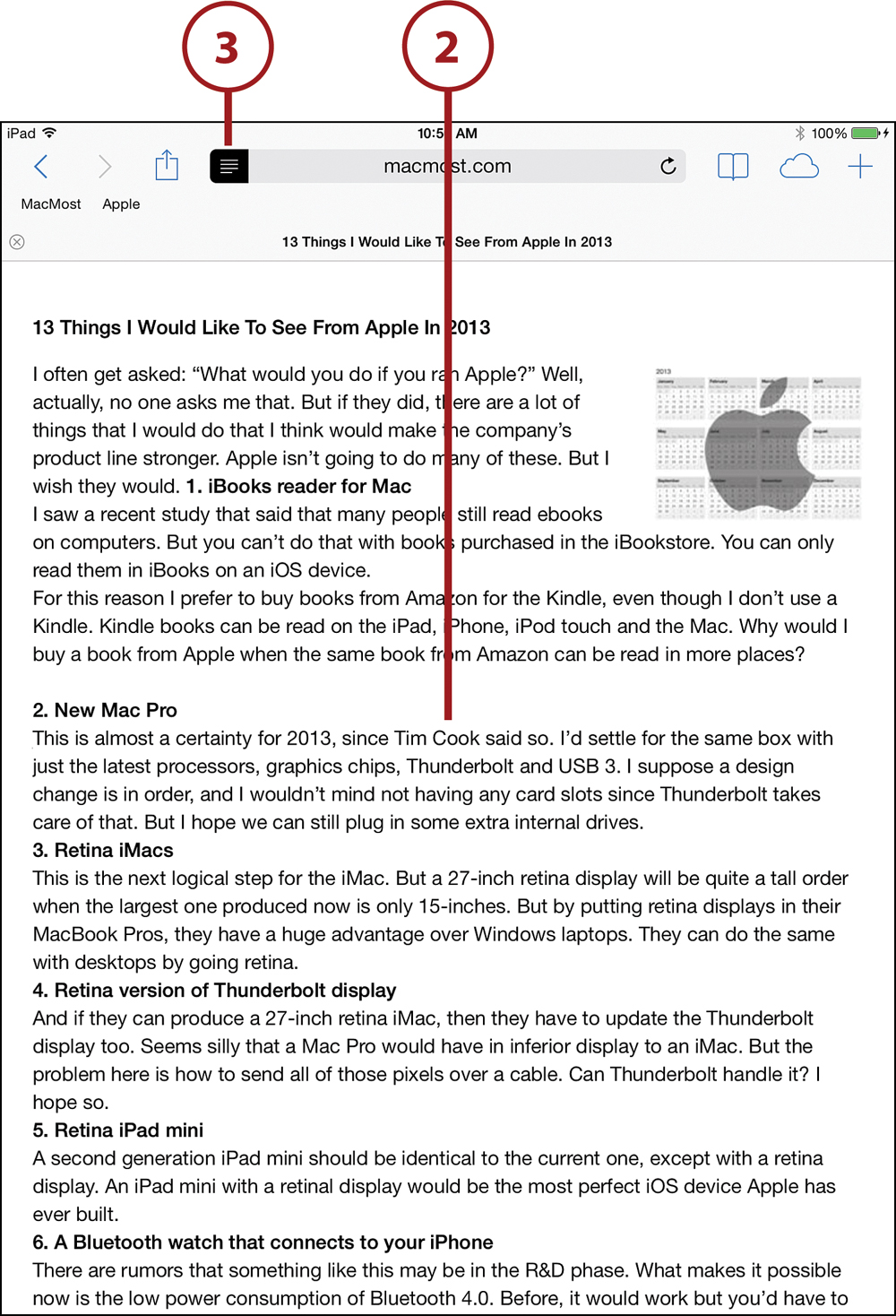
Reader Font Size
Previous versions of Reader have allowed you to change the font size at the top of the page. You can still change the font size, but not as easily, and not just for Reader. In the Settings app, go to General, TextSize. You can drag a slider there to increase the font size used by Safari’s Reader feature. This will affect other apps as well, such as Mail and Notes.
Saving Time with AutoFill
When you go to websites and fill out forms, it can be annoying to type out basic information like your name and address, or your user ID and password. Furthermore, if you have to type your password every time you visit a site, or even on a daily or weekly basis, this encourages you to use simple, easy-to-guess passwords so you don’t have to type long complex strings of characters.
The Keychain function built into Safari allows you to automatically fill in forms and login prompts. After you enter your information the first time, you never have to do it again for that website.
Setting Up AutoFill
To set up AutoFill in Safari, start by going to the Settings app.
![]() Tap Safari in the Settings app.
Tap Safari in the Settings app.
![]() Tap Passwords & AutoFill.
Tap Passwords & AutoFill.

![]() Slide the Use Contact Info switch on, if it’s not. Now any time you go to a web page with a form that asks for basics like name, address, or telephone number, AutoFill uses your contact information in the Contacts app to fill those fields automatically.
Slide the Use Contact Info switch on, if it’s not. Now any time you go to a web page with a form that asks for basics like name, address, or telephone number, AutoFill uses your contact information in the Contacts app to fill those fields automatically.
![]() Tap My Info to tell Safari which contact in the Contacts app is you.
Tap My Info to tell Safari which contact in the Contacts app is you.
![]() Slide the Names and Passwords switch on to have Safari remember user IDs and passwords when you log on to websites. As you will see in the next section, Safari prompts you each time you enter a new User ID and Password so you can decide the passwords that are saved.
Slide the Names and Passwords switch on to have Safari remember user IDs and passwords when you log on to websites. As you will see in the next section, Safari prompts you each time you enter a new User ID and Password so you can decide the passwords that are saved.
![]() After you have visited some sites and saved some passwords, you can access the list of saved passwords by tapping Saved Passwords.
After you have visited some sites and saved some passwords, you can access the list of saved passwords by tapping Saved Passwords.
![]() Tap on any entry to view the ID, password, and the website it belongs to.
Tap on any entry to view the ID, password, and the website it belongs to.
![]() You can enter Edit mode to delete entries.
You can enter Edit mode to delete entries.
![]() Safari can also remember credit card information. Slide the Credit Cards switch to on for this information to be saved.
Safari can also remember credit card information. Slide the Credit Cards switch to on for this information to be saved.
![]() Tap Saved Credit Cards to see a list of your saved credit cards and to add new ones. When you add a credit card, include your name, the card number, the expiration date, and a short description. However, the security code for the card is not saved. Most websites will ask you for this even after Safari has autofilled in the information it has saved.
Tap Saved Credit Cards to see a list of your saved credit cards and to add new ones. When you add a credit card, include your name, the card number, the expiration date, and a short description. However, the security code for the card is not saved. Most websites will ask you for this even after Safari has autofilled in the information it has saved.

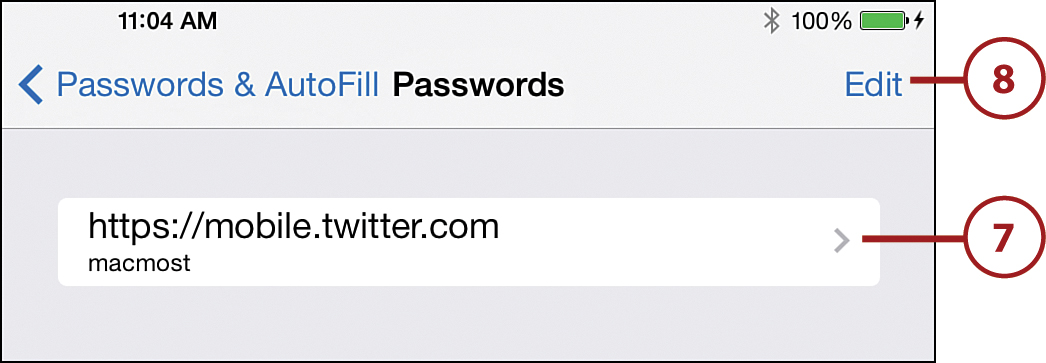
Using AutoFill
After you have AutoFill set up, using it is relatively simple. You can use it with a form that asks for basic contact information, or for a login form. The process is the same. Let’s look at using it with a simple login form.
![]() Enter an ID or password at a website.
Enter an ID or password at a website.
![]() If AutoFill is enabled, you may be prompted by Safari to save the password.
If AutoFill is enabled, you may be prompted by Safari to save the password.
![]() Tap Save Password to save the user ID and password.
Tap Save Password to save the user ID and password.
![]() Alternatively, you can tell Safari that you don’t want to save the password for this site, and not to ask again.
Alternatively, you can tell Safari that you don’t want to save the password for this site, and not to ask again.
![]() You can also skip this for now. This is useful if you have multiple logons for a site and don’t want to save the one you are using at this moment.
You can also skip this for now. This is useful if you have multiple logons for a site and don’t want to save the one you are using at this moment.
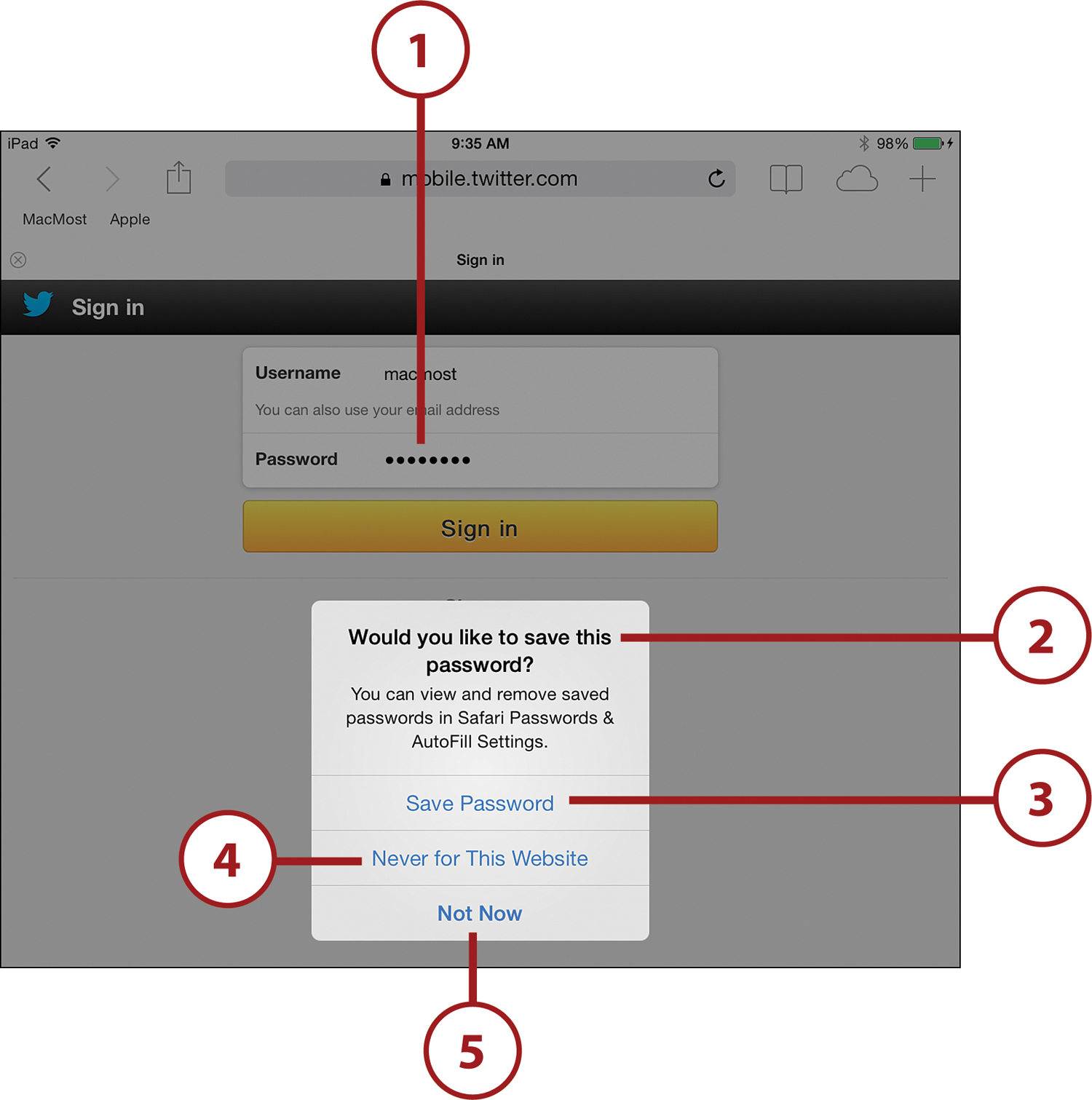
![]() Log out and then return to the same website.
Log out and then return to the same website.
![]() You’ll notice that the ID and password are already filled in. The fields turn yellow to show that AutoFill has been used to fill them in.
You’ll notice that the ID and password are already filled in. The fields turn yellow to show that AutoFill has been used to fill them in.
![]() Tap the button used by the site to complete the login.
Tap the button used by the site to complete the login.
![]() On some websites, the information might not fill in automatically. You can try tapping the AutoFill Password button to force it.
On some websites, the information might not fill in automatically. You can try tapping the AutoFill Password button to force it.

